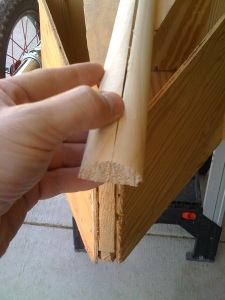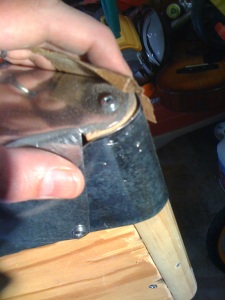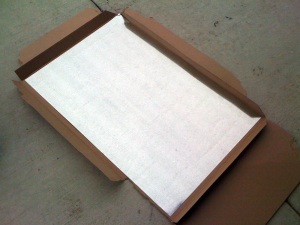Hard to believe we started this kart on Father’s Day 2009, but as they say, getting there is half the fun. In our last weekend we were able to get the body all taped off and primered. Since then our ghost of a kart has just been taunting me from the garage. I’d walk by and think “Man is that ugly…” but luckily this stage is only temporary.
This most recent weekend I was bound and determined to get some color on our kart. My wife asked me if we had anything planned, but before I could respond she reminded me that we had cub scouts, baseball opening day, and two birthday parties to contend with. But I want to paint the go kart? I found that it was best to not let on just how much time I was willing to spend on this little project, often going so far as to pretend I forgot all about it. But I think she knows.
We needed a fluorescent lightbulb so I had the perfect excuse to find myself at Lowes. Conveniently I found myself in the paint aisle so I started looking at one color after another wondering just what we should paint our kart. Granted, the house paint aisle at the local hardware store isn’t typically where one would go to find paint for a car of sorts, what with the selection of Disney and Ralph Lauren crackle paint to choose from. As tempting as a faux leather wash would be, I just wanted to find a vintage color that was reminiscent of those vintage cars. A red, the given Bugatti blue, black, or even a vanilla or off white would look great.
I pulled out my iPhone (where I just happened to have a Bugatti picture) and realized that I just had to go with the old stand by. It was decided. I found myself leaving Lowe’s with a gallon of Lowe’s Olympic brand paint, color A52-2 Magical Merlin, or as we would call it Bugatti Blue, semi-gloss. And of course my fluorescent lightbulb.
We had our kart all taped up from the previous work so there really wasn’t much left to do except dig in and start painting. The paint went on as you would expect, like house paint.
Since we were covering with a fairly dark color (vs say eggshell on a wall) I was a bit surprised how much it took to cover the white primer. Not the whole gallon, but a few coats for sure. We started at the tail and worked our way down the frame and around the front.
The front upper and lower control arms were a bit tedious to get the brush into the nooks and crannies, and clearly a spray can would have done the trick just fine. But again, I just didn’t want to deal with the overspray and all that fun stuff.
One of the boys started off helping but I sensed he could recognize my apprehensiveness when he painted. I had this vision that the paint was all splashed on and was just a mess, and when he started painting in all directions I’d find myself saying “Ahhh, here let me help you…” only to stop myself from yanking brush out of his hand. I kept reminding myself, he’s having a good time here as well, so I let him continue on.
We kept on with our work. After a bit Nick ran off to scatter various toys up and down the street so I was left to my own devices. The challenge was that I had a birthday party pick up for our oldest son in about an hour. I could do it.
I went around the front, covering the grill, and then down the passenger side meeting back up again with the tail where we had started. Since all the hardware was still taped off with blue 3M painters tape, and the entire kart was now blue, it was starting to resemble something a Smurf may drive around.
One of the boys came up and when it was mostly completely covered and simply said “Dad that’s a whole lotta blue.” I wanted to reply with “Whole lotta Bugatti blue…” but I just asked him what he thought. He loved it.
It does seem like one big blue blob, but you have to remember we’re going to get our chrome exhaust back on, paint some racing numbers, etc. It’s going to look great I think when we’re all set.
With the exterior of the body now painted I wondered what am I going to do with the interior? In hindsight it would have been a good idea to have painted the body on the inside as I assembled it. But live and learn. I’ll do that with the next one. The boys are each now asking for their own, with of course a motor.
I’d like to figure out if I can simply get some pleather for a seat but we’ll have to see. Next step will be to get our pieces back on, and tackle the grill I think. I have some great ideas on using window screen so stay tuned for that one.
Oh yeah, happy birthday Dad.




























